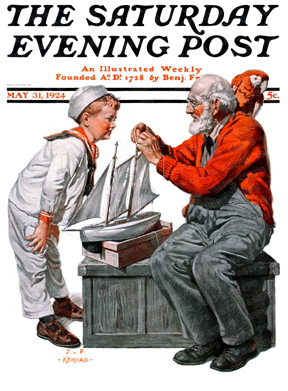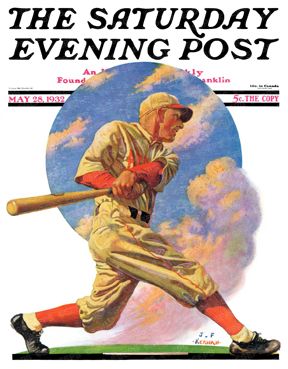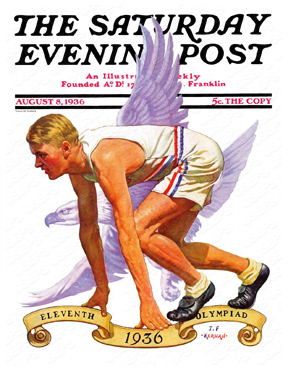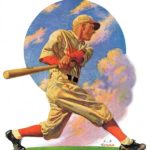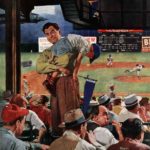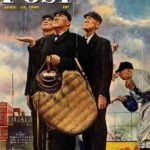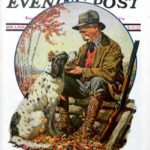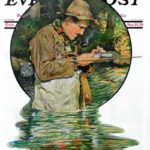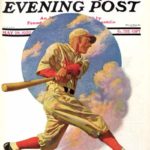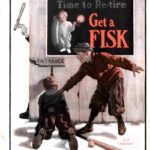Olympic Covers
Sprint, scull, and soar your way to Olympic history with these classic Post covers commemorating Games of the last century.
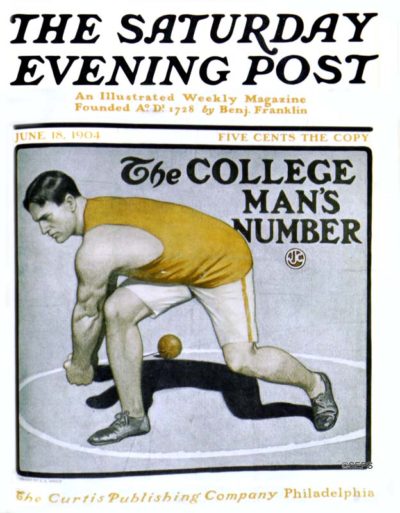
This Olympic hopeful’s number may indeed come in, providing he can heave this hammer far enough afield.
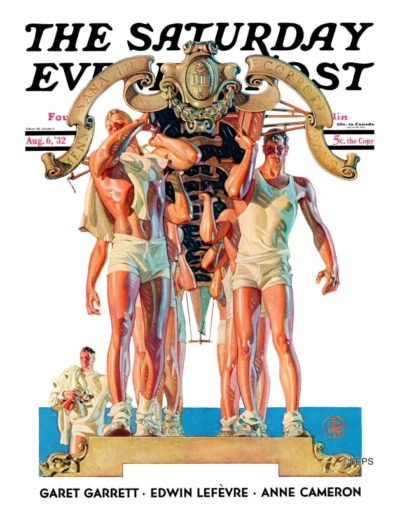
J.C. Leyendecker
August 6, 1932
On this August 1932 cover, J.C. Leyendecker accurately predicted the future, placing the U.S. men’s eight rowing team on the winner’s pedestal a week before the finals. The only bronze they wore that year came from the sun.
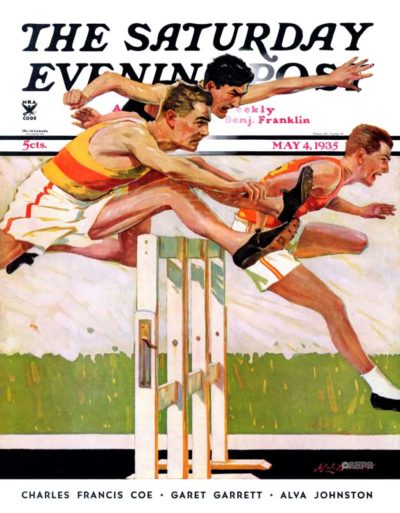
May 4, 1935
A year in advance of the 1936 Berlin Games, these Olympic hopefuls hurtle and hurdle for a chance to compete on the world stage. It might be their last chance: After 1936, World War II pre-empted the Games until 1948.
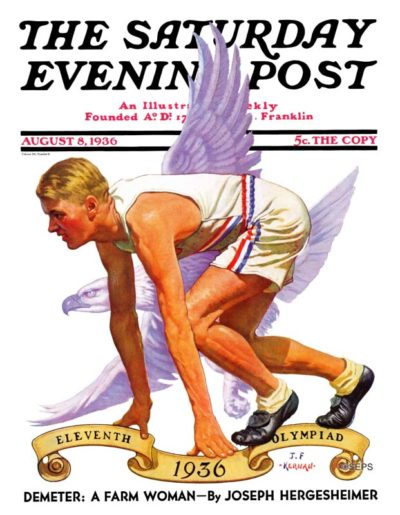
J.F. Kernan
August 8, 1936
In J.F. Kernan’s last Post cover, an Olympic sprinter channels the strength and speed of the eagle as he prepares to represent America at the 1936 Olympic Games in Berlin.
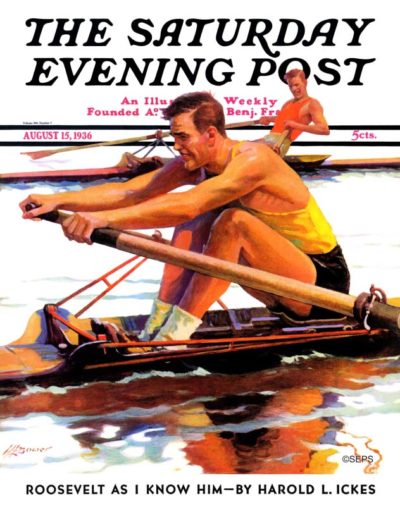
August 15, 1936
This Olympic single sculler had best grit his teeth and grind those delts with a tad more gusto if he hopes to reach the podium.
Joseph Francis Kernan
American illustrator J.F. Kernan (1878–1958) specialized in images of middle-class life for the covers and pages of popular magazines from the 1910s to 1940s. His nostalgic and often humorous illustrations celebrate the simple comforts of home, family, and outdoor recreation.
Born in Brookline, Massachusetts, Kernan studied and taught at the Eric Pape School of Art in Boston before embarking on his career as a professional artist. He became a well-known artist whose works soon graced the covers of nearly every major magazine during the 1920s and 1930s including The Country Gentleman, Outdoor Life, Collier’s Liberty, Capper’s Farmer,The Elks, and the Associated Sunday. His work was also featured on calendars and advertisements of the period. His credits include 26 covers for The Saturday Evening Post between 1924 and 1936.
Covers by J.F. Kernan
Model Ship
J.F. Kernan
May 31, 1924
Baseball Batter
J.F. Kernan
May 28, 1932
Eleventh Olympiad
J.F. Kernan
August 8, 1936
Purchase prints of J.F. Kernan’s work at Art.com.
Kernan was 45 years old when his first Post cover appeared on newsstands May 31, 1924, depicting an old sailor, with a parrot on his shoulder, working on a model ship while a young sailor looks on. An outdoorsman as well as an athlete (he played professional baseball to help finance his art education), Kernan would frequently incorporate those themes into his work. Hunting and fishing were popular topics. His art captured, as he described it, “the human side of outdoor sports, hunting, fishing and dogs.”
Kernan’s final Post cover, The Sprinter, honored the Olympic Games. It was a fitting finish because so much of his life’s work commemorated sportsman and outdoor life.
Joseph Francis Kernan died in 1958.
Beyond the Canvas: The Permanence of Baseball
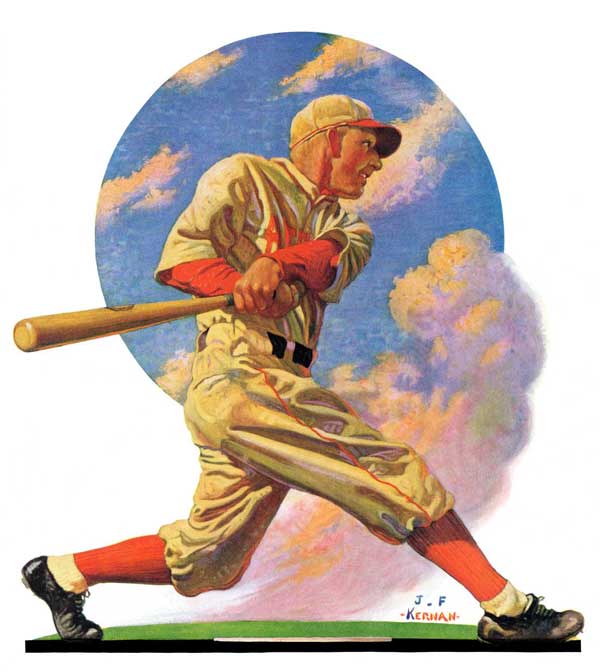
J.F. Kernan
May 28, 1932 © SEPS
Attending a game of America’s favorite pastime is a cultural experience. Scattered across our largest cities and smallest towns, baseball diamonds are famous for their fresh-mown grass, peanut-callers, fighting umpires, and of course, hot dogs and Cracker Jacks. Throughout the twentieth century, The Saturday Evening Post has filled its covers with images of a day at the ballpark.
Traditions big and small helped cement baseball’s dominance in our national sports history.
Beginning with J.F. Kernan’s May 28, 1932 cover Baseball Batter, we see the sport’s uniforms haven’t changed much in the last eighty-two years, and today the atmosphere of a ballpark is much the same as it was back then. Watching from the stands with a beer and a hot dog on a sunny day, one might see a similar batter swinging away over home plate.
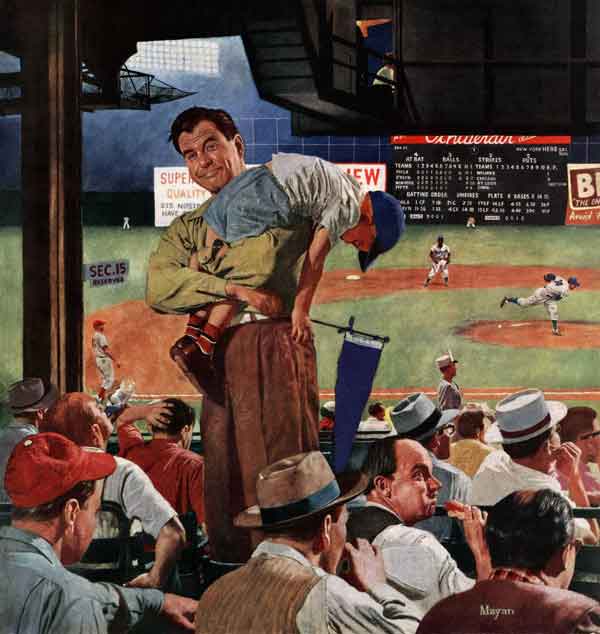
Earl Mayan
April 23, 1955 © SEPS
And how does America get hooked on the game? Earl Mayan’s cover from gives us the explanation. Sleepy Inning shows a father carrying one tuckered out little boy from the stadium. Pennant in hand, the young fan must have cheered himself to exhaustion.
Many American parents start their children on the sport at a young age with little league or t-ball, sometimes before they’re even strong enough to hit a pitch. We also get hooked as a family, since games are an iconic family event–perhaps more so for fathers and sons–where we make memories and form bonds. In the stands, spectators of all ages watch the game while dads shimmy through the crowd with staples from the concession stands.
Rockwell’s Bottom of the Sixth (Three Umpires) from April 23, 1949 focuses on the dour prospects of a universal disappointment–a rained out game. While two team managers fight about whether a player was safe or out, the umpires focus on falling droplets from rumbling storm clouds overhead. Rockwell’s title connotes dread. If the ballpark has to wait for the storm to pass, it’ll be quite a long seventh inning stretch.
Styles and fads have come and gone with each new decade in America’s history, but baseball has stayed nearly constant. Whether you visit Fenway in Boston or Wrigley in Chicago, fans of all ages still cheer from the stands over the sounds of cracking bats and hollering concessioners. As The Saturday Evening Post covers show, we can relate, at least in one way, to the past through the maintained traditions of this shared sporting experience.
J.F. Kernan
May 28, 1932 © SEPS
Earl Mayan
April 23, 1955 © SEPS
Norman Rockwell
April 23, 1949 © SEPS
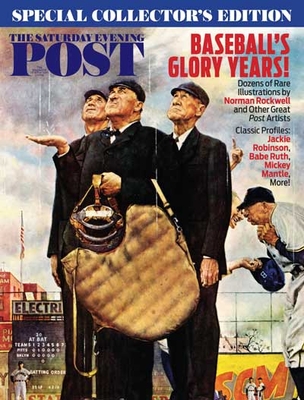
Baseball lovers: Don’t miss our Baseball Special Collector’s Edition!Celebrate nearly 200 years of America’s favorite pastime with striking illustrations by Norman Rockwell and other great American artists, rarely seen photos, and stories by the greats and about the greats from the pages of The Saturday Evening Post.Click here to purchase your copy while supplies last!
Classic Covers: The Art of J.F. Kernan
An athlete and outdoorsman, artist Joseph Francis Kernan was known as the “poor man’s Norman Rockwell.” But Kernan was a superb illustrator in his own right.
During the 1920s and ’30s, J.F. Kernan (1878-1958) illustrated nearly 30 Post covers. Some, such as his beautiful 1927 cover (below), depicted the seaside or old sailors.
Born in Brookline, Massachusetts, Joseph Francis Kernan attended the Eric Pape School of Art in Boston and later taught at the school before embarking on his art career.
His art featured, as he described it, “the human side of outdoor sports, hunting, fishing, and dogs.”
From humor back to his outdoorsman passions, one of Kernan’s finest works is this fisherman tying a fly from 1929. The color palette is subtle but stunning, and the rippling water looks good enough to jump into.
His work also appeared on covers of major magazines of the time, including The Country Gentleman, Outdoor Life, and Collier’s Liberty.
Like most illustrators of this era, Kernan did artwork for ads. All of his art varied from the picturesque to wry comic situations.
His baseball cover, for example, is picturesque, but in the ad from 1926 for Fisk Tires we have a couple of boys about to get in trouble for watching a game through a peephole instead of paying admission—not an uncommon theme for the 1920s.
(Interestingly, baseball was not just a mere spectator sport for Kernan. He helped finance his art education for a period of time as a professional baseball player.)
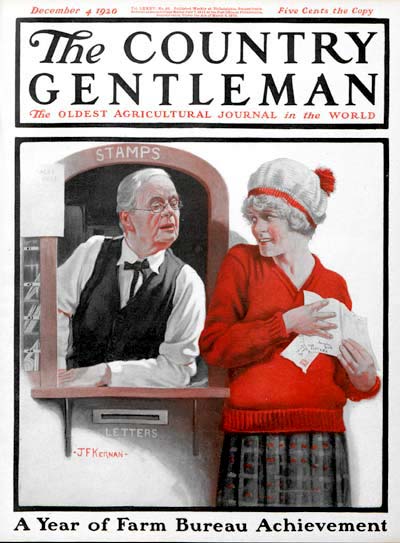
from December 4, 1920
Another theme illustrators enjoyed was the nosy post office worker (or neighbor or party-line sharer).
You can see the theme in Kernan’s 1920 cover for the Post‘s sister publication, The Country Gentleman.
If you’re familiar with Post covers, you’ll also notice that there’s some resemblance in Kernan’s early artwork to his contemporary, Norman Rockwell.
In this cover it is 1922, and one supposes there must be a downside to women getting the vote.
Reprints of The Saturday Evening Post covers are available at Art.com.
Classic Covers: Fall Hunting Season
Our cover artists have depicted hunters, both comical and serious, since 1900. Here are a few.
No Hunting – Douglass Crockwell
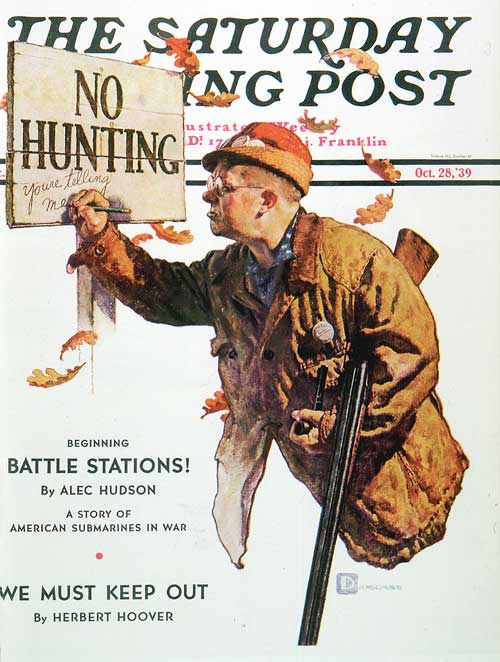
Douglass Crockwell
October 28, 1939
I’ve always gotten a chuckle from this 1939 cover by artist Douglass Crockwell. No only did this hunter ignore the warning, he’s mad enough to add his own commentary – under the big “NO HUNTING” letters he’s scribbling, “You’re telling me.” Notice that the artist simply signed his covers “Douglass”. This was to avoid confusion with another artist – some guy with a similar last name.
No Hunting – Leslie Thrasher
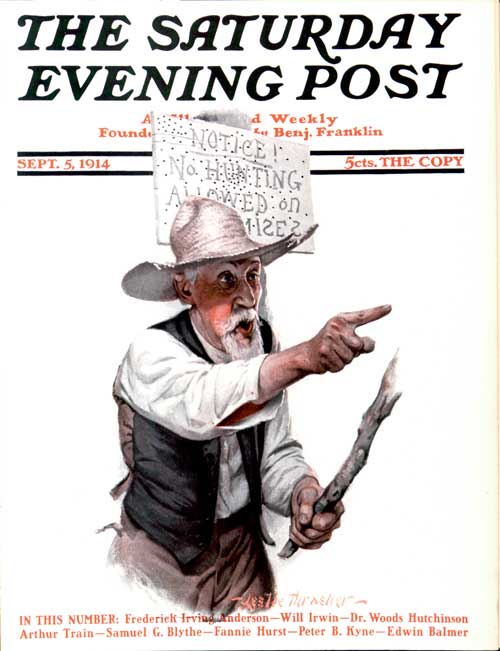
Leslie Thrasher
September 5, 1914
When this guy says “no hunting,” he means it! One might say there have been flagrant violators, since the sign is riddled with bullet holes. We’ve had some cover artists who were wonderful at painting old codgers, and Leslie Thrasher was one of them. This cover is from 1914.
Springer Spaniels – J.F. Kernan
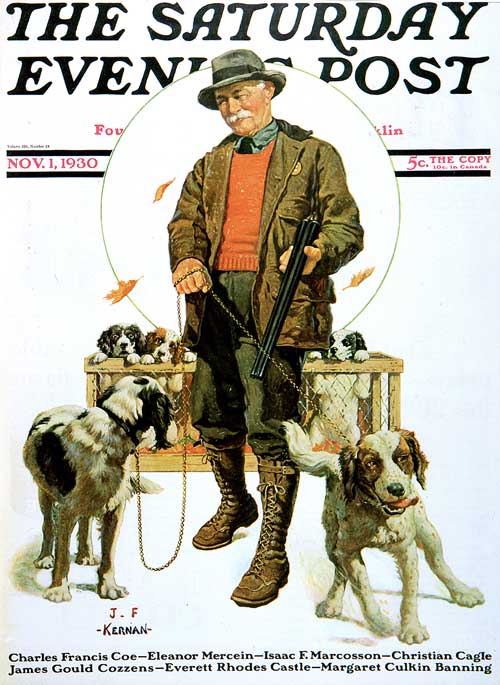
J.F. Kernan
November 1, 1930
I’d know that white mustache anywhere; this gentleman appeared in many beautiful J.F. Kernan covers. In this 1930 cover, he’s dressed for the hunt and picking up spaniels for the job. When the little pups grow up, they’ll be great hunters, too.
Duck Hunters – Robert Robinson
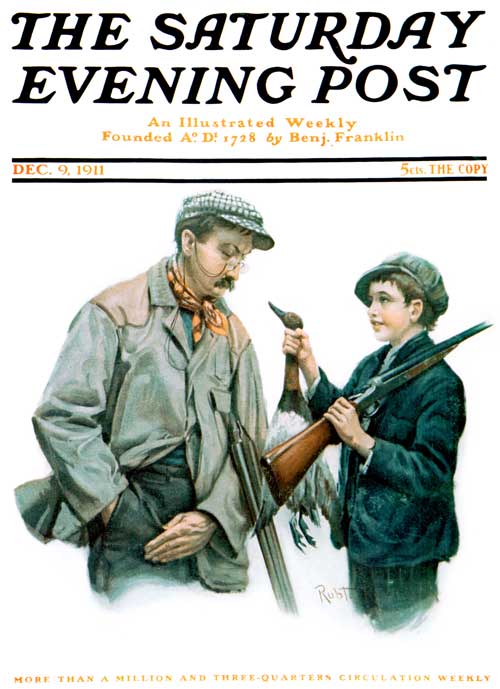
Robert Robinson
December 12, 1911
Now we all know that hunters and fishermen are the most honest and upright of sportsmen. But there’s not only this 1911 cover of an unsuccessful hunter buying someone else’s catch, there’s a cover a few years later depicting a fisherman doing the same thing. Who wants to go home after hours of hunting or fishing with nothing to show for it?
Patient Dog – John Atherton
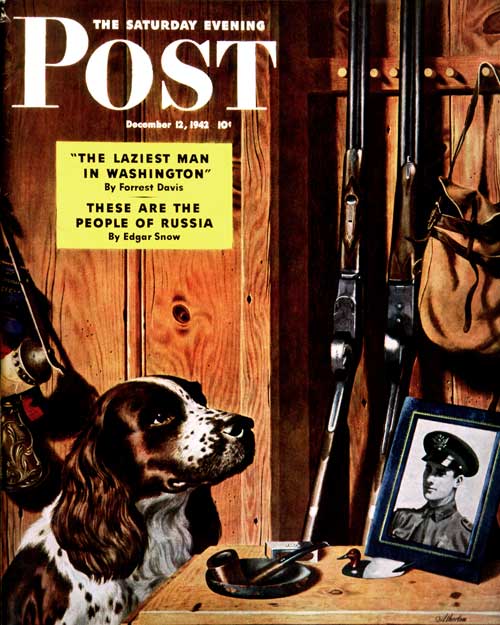
John Atherton
December 12, 1942
This is a sweet one. World War II has taken the man of the house away and this beautiful dog is waiting patiently for his master to return and take him hunting. Not all of those waiting at home are two-legged.
Hunting Couple on Walk – J. Hennesy
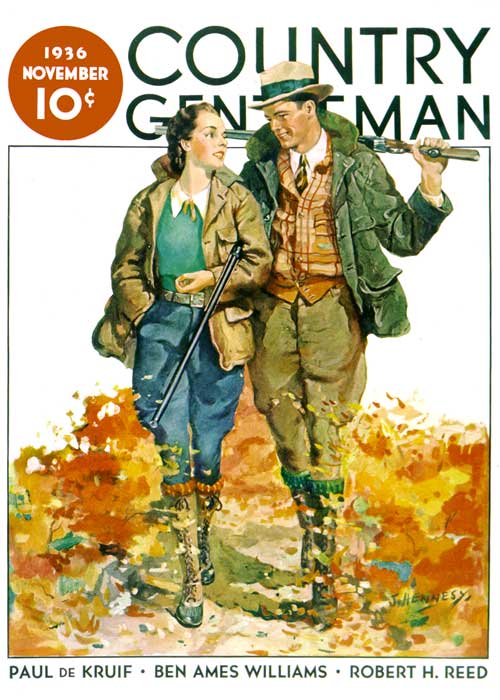
J. Hennesy
November 1, 1936
It’s a crisp autumn day, and together time for this couple means hunting – or at least walking in the woods. Country Gentleman magazine was a sister publication to the Post for many years and often shared the same artists.
Classic Covers: How Labor Has Changed
You don’t often see a coachman these days, or a blacksmith. In honor of Labor Day, we invite you to think of other professions that have ceased to exist as you enjoy yesterday’s labors as shown on our covers.
Coachman and Horse by J.F. Kernan
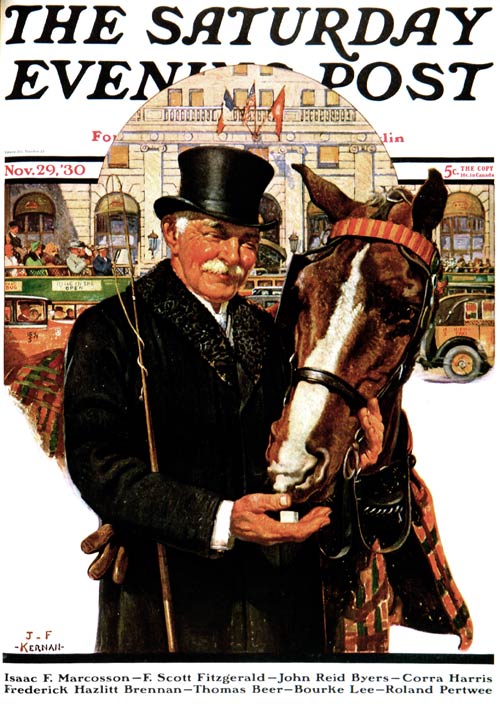
J.F. Kernan
November 29, 1930
If you think I’ve been looking for an excuse to show off this beautiful cover, you’re absolutely right. The coachman and horse is one of my favorites (of course, my favorites change from week to week). Between the Post and sister publication, Country Gentleman, artist J.F. Kernan did over fifty covers.
Billboard Painters by Penrhyn Stanlaws
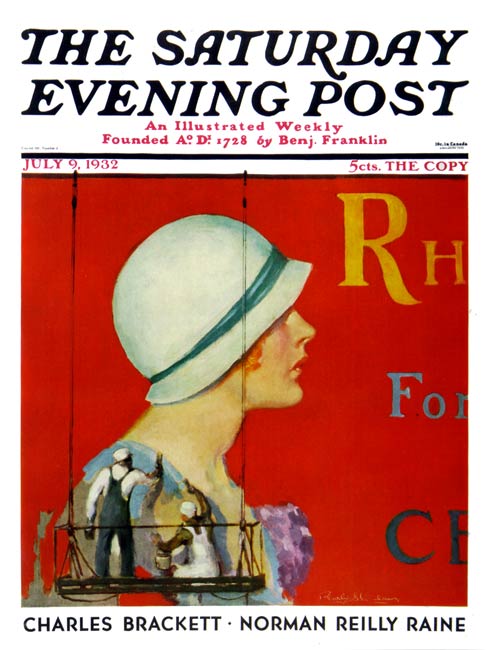
Norman Rockwell
March 9, 1935
There are several covers depicting billboard painters, and I’d forgotten about this one. It was by artist Penrhyn Stanlaws whose covers of elegant ladies, often in interesting hats, graced the Post many times. This particular lady just happens to be several times life size.
Partygoers by Norman Rockwell
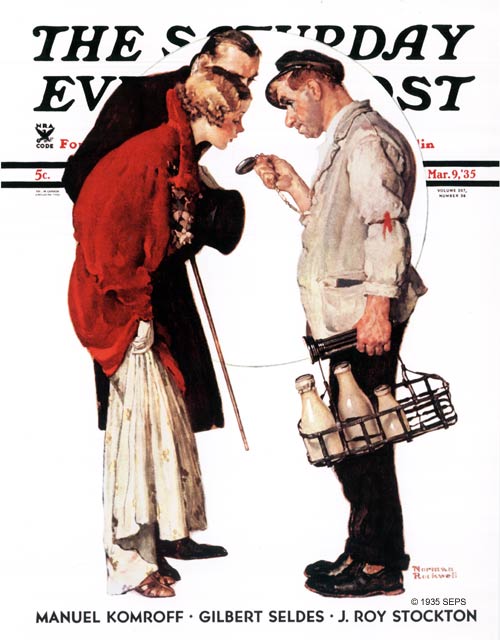
Norman Rockwell
March 9, 1935
The milkman started at the crack of dawn, so if you met him on your way home, you were a bona fide party animal. Note the hard-working deliverer of our morning milk is still carrying his flashlight. Rockwell depicted him as a fatherly type, admonishing the young couple for their unseemly hours.
Blacksmith by L.L. Emmert
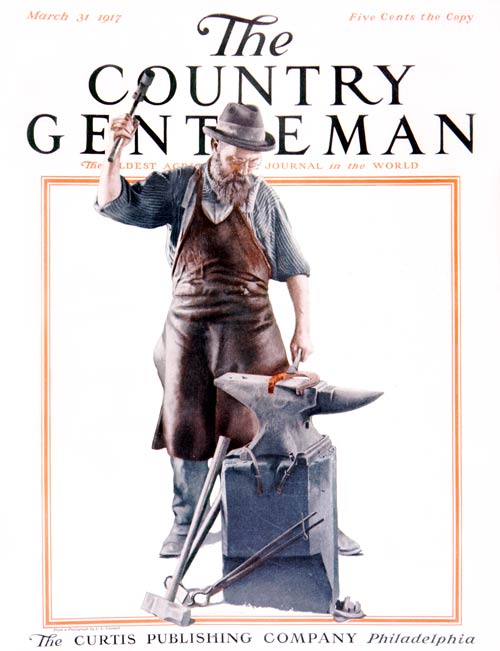
L.L. Emmert
March 31, 1917
Since the Country Gentleman magazine folded in the 1970’s, a lot of cover art is all but forgotten. Today we’re remembering the blacksmith at his labors in 1917. What’s a horse to do these days – go to a shoe store?
Fill ‘er Up by McCauley Conner
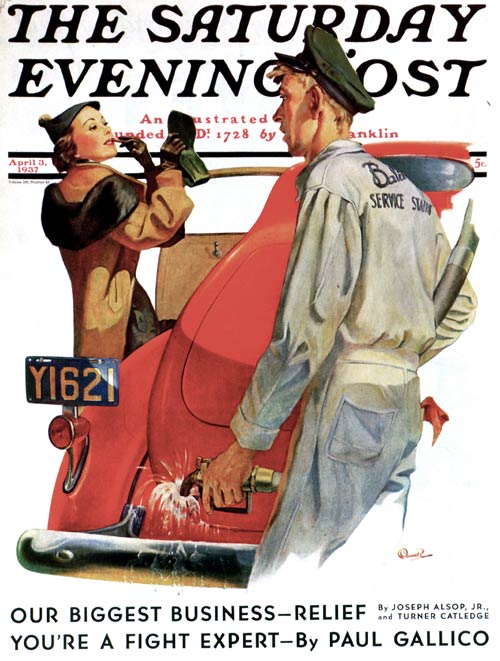
McCauley Conner
April 3, 1937
I suppose remembering the days when someone pumped your gas makes you officially old, but it’s another job that’s gone by the wayside. I never thought the reason might be gas station attendants like this one, who got distracted by pretty ladies. This could get costly these days!
Soda Jerk by Norman Rockwell
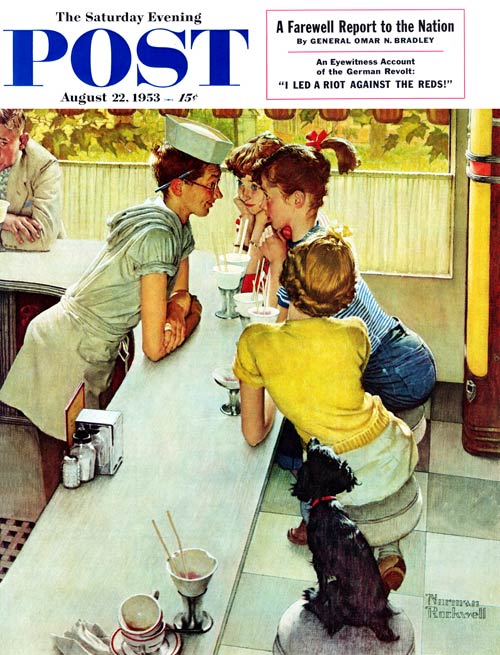
Norman Rockwell
August 22, 1953
Yes, there were perks to being soda jerks – like girls. Norman Rockwell got the idea for this cover by listening to his youngest son talk about his experience behind the soda fountain. And, yes, Peter Rockwell was the model, although he wasn’t all that pleased with the resulting painting. “I’m not that goofy-looking,” he said. Well, dad had to give the guy some “character”. See if you can dream up any other extinct professions.
